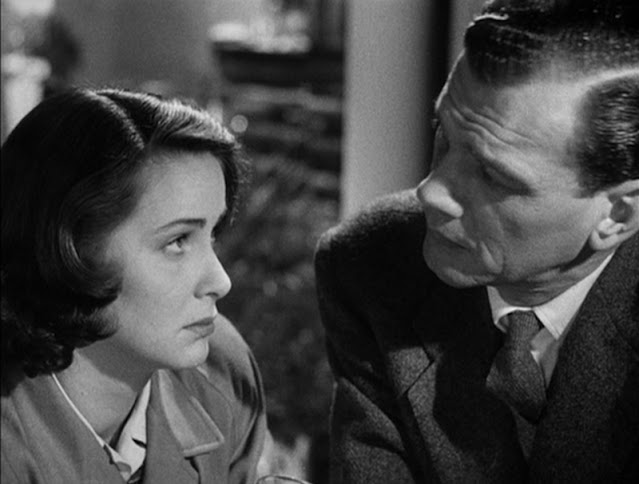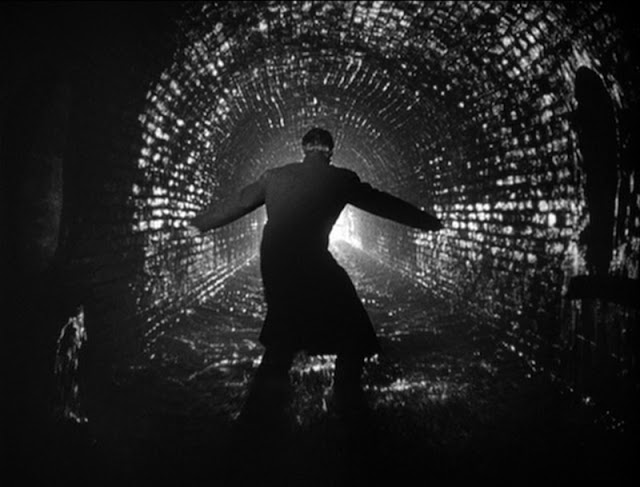(1949) Directed by Carol Reed; Screenplay by Graham Greene; Based on a novella by Graham Greene; Starring: Joseph Cotten, Alida Valli, Orson Welles, Trevor Howard, Paul Hörbiger, Ernst Deutsch, Erich Ponto; Available on Blu-ray and DVD
Rating: *****
“Carol Reed is the kind of director who’ll use any ideas –
anything that’s going. I had notions for the dialogue, and Carol liked them.
Except for my rather minor contribution, the story, of course, was by the
matchless Graham Greene. And the basic idea – though he took no credit for it –
was Alex Korda’s.” – Orson Welles (excerpted from This Is Orson Welles,
by Orson Welles & Peter Bogdanovich)
Not every monster has sharp teeth and claws, or glowing red eyes, yet they’re monsters all the same. The Third Man features a monster of a different sort – Harry Lime. As portrayed by the incomparable Orson Welles, man and monster are inseparable. While Lime doesn’t even make his appearance until an hour into the film, his presence is felt throughout. As preparation for his novella and subsequent screenplay adaptation, Graham Greene visited Vienna for a first-hand view of the city’s people, culture and nightclubs. Director Carol Reed shot the film mainly on location,*/** except for a sewer set*** that was built in Shepperton Studios.
* Fun Fact #1: Shooting was divided into three units, day, night and sewer, which ran nearly 24 hours a day, six days a week. Reed insisted on directing all three, and would spend Sundays catching up on sleep. His secret? Benzedrine. Maybe it’s just me, but wouldn’t “Carol Reed on Speed” make a terrific band name?
** Fun Fact #2: James Bond fans, take note: Bernard Lee (Q) co-stars as Sergeant Paine, and Assistant Director Guy Hamilton went on to direct several films featuring Agent 007.
***
Fun Fact #3: Welles was reputedly so disgusted after a day of shooting in
Vienna’s sewers, that he refused to return to the damp (and rank-smelling)
location, necessitating the construction of an elaborate set in England.
Holly Martins (Joseph Cotten),* an American writer of pulp novels, arrives amidst the ruins and rubble of postwar Vienna (a city under the shared jurisdiction of American, British, French and Russian troops) to meet his friend, Harry Lime, who promised him a job. Unfortunately for the penniless Martins, he’s arrived a day too late, as he learns that Lime was killed in a freak pedestrian accident – Or was he? Plagued by doubt, and fueled by Lime’s evasive friends and business associates, he sets out to find the truth. One palpable link is Lime’s girlfriend, Anna Schmidt (Alida Valli), who seems to know more than she’s telling. The more he learns about Lime’s shady dealings (thanks to the unflappable Major Calloway, who oversees the British sector of the city), the less allegiance he feels toward his old chum. As the weight of his conscience bears down, Matins is faced with the unenviable task of helping to turn in his best friend to the authorities.
*
Fun Fact #4: Reed reportedly wanted James Stewart to play the role of Holly
Martins.
Although The Third Man is arguably Joseph Cotten’s movie, it’s impossible to downplay Orson Welles’ significance in the film. Outside of the role of Charles Foster Kane, Harry Lime is among Welles’ most memorable performances. When Lime finally appears in the film, what an entrance it is, as he emerges from the shadows, with a roguish gleam in his eye, grinning like a cat who devoured a canary. Behind that amiable façade, however, is an amoral, calculating profiteer who ghoulishly preys on the city’s most vulnerable residents (dealing in diluted penicillin). When Martins confronts Lime about the ramifications of his business dealings, Lime (in the film’s most chilling speech) glibly defends his actions. From their vantage point atop the city’s giant Ferris wheel,* Lime casually gestures toward the people below, wandering the amusement park’s macadam. To him, they’re insignificant “dots,” who signify money and nothing else. It’s only fitting that he trades his lofty position for the sewers **/*** in the film’s climactic chase scene, emblematic of the depths that he’s sunk.
* Fun Fact #5: The historic 212-foot Wiener Reisenrad Ferris wheel was built in 1897, and refurbished in 1947. The enduring Vienna landmark is still operating today.
** Fun Fact #6: One of the most popular (and unlikely) tourist attractions in Vienna is the guided tour of the sewers, appropriately called, “The Third ManTour.”
***
Fun Fact #7: In the famous shot of Lime’s fingers poking out of the sewer grate,
the writhing digits belonged to director Reed, not Welles.
Anton Karas’ infectious zither score is arguably just as iconic as Welles’ famous entrance. Discovered in a Vienna heuriger (wine tavern),* the diminutive musician and his instrument captivated Carol Reed. Despite studio objections, the director insisted on ditching the conventional symphonic score, in favor of Karas’ music. The results bring an immediacy to the story, evoking aural imagery of old, pre-war Vienna. At the same time, the score, alternately mournful and joyous, captures the flavor of a present-day city divided physically, ideologically and morally.
*
Fun Fact #8: The formerly unknown zither artist rose to the top of the charts
in the U.K. and U.S. with his “The Third Man Theme.” He used some of his
newfound riches to open up his own wine tavern, appropriately named Zum Dritten
Mann (aka: “The Third Man.”).
Ambivalence
is a driving theme that runs throughout The Third Man. Not only Lime,
but all the principal characters operate in shades of gray, tipping the balance
between selfishness and altruism. The people of postwar Vienna act out of
desperation and necessity, with many residents resorting to all sorts of schemes
and petty larceny to get by. Lime’s friends embody this prevailing cynicism,
with no one’s motives entirely pure. It’s easier to look away than get involved.
But some crimes are far from victimless. Martins is presented with a grim
reminder of the stakes he’s playing by initially defending Lime. En route to
the airport, Major Calloway (Trevor Howard) takes him on a detour to visit a
ward full of children dying from meningitis – collateral damage from Harry Lime’s
scheme. In this heart-wrenching scene, the children are never seen, but their
pain and suffering are felt through the dour expressions of Martins and
Calloway. A pile of discarded teddy bears drives the message home.
So, who is Harry Lime? He’s a profiteer – no, an entrepreneur. He’s a loyal friend – no, your worst enemy. He has all the answers – no, he has none of them. He’s cold-hearted – no, he’s a realist. But let’s not belabor the point. Above all, he’s a charmer. The thing that makes him so appalling is that he’s so appealing. His friends and acquaintances are ready to accept whatever he says as fact. His casual air of authority provides no time to question the veracity of his claims. Perhaps the most monstrous thing about him is that he makes it too easy to see a little bit of ourselves, at our darkest. While you won’t likely find The Third Man on any lists of monster movies, perhaps it should be.
Sources
for this article: Who Was the Third Man? (2000 documentary), “Insider Information,”
Criterion DVD supplement; This Is Orson Welles, by Orson Welles &
Peter Bogdanovich (1992); The Amusement Park, by Stephen M. Silverman
(2019)








Great review, barry!
ReplyDeleteThe third man has been on my list for a while, but now I need to bump it up a few notches!
Also, I agree. Carol Reed on speed would make a great name for a band! Lol
Thanks, John! Go see it. You won't be sorry. ;) Maybe I'm onto something with naming bands.
Delete